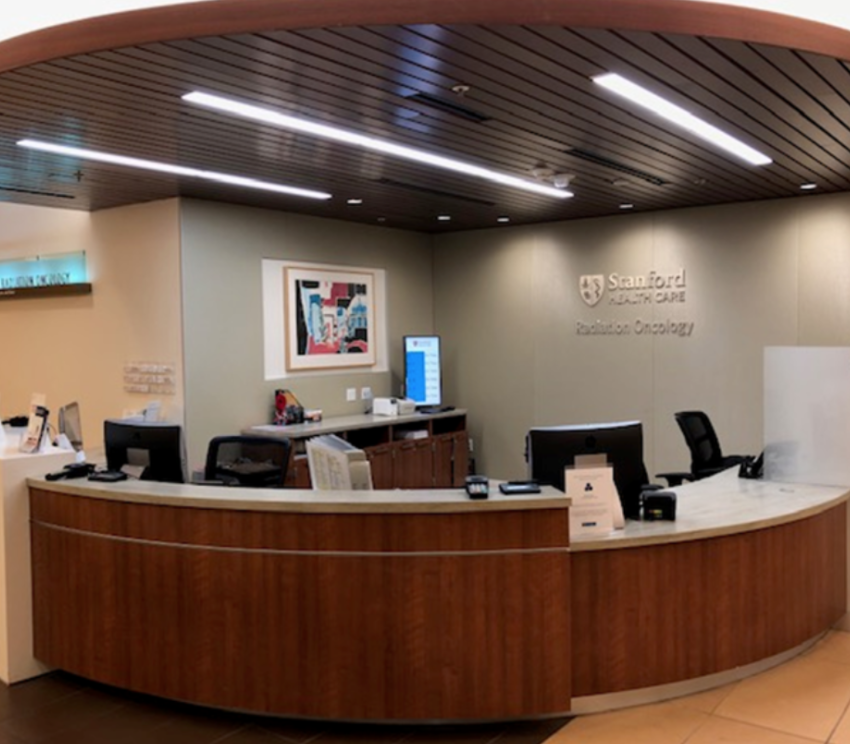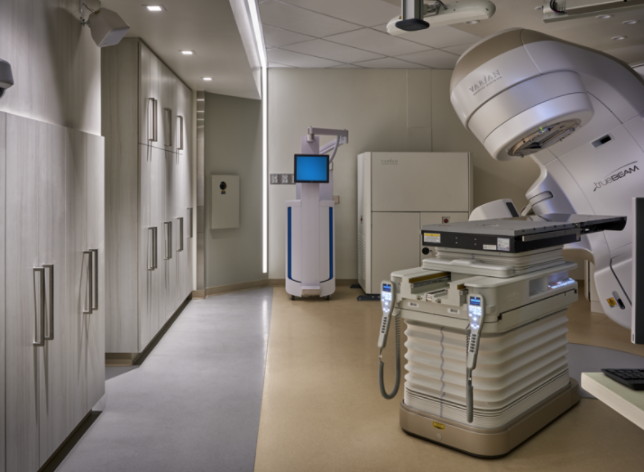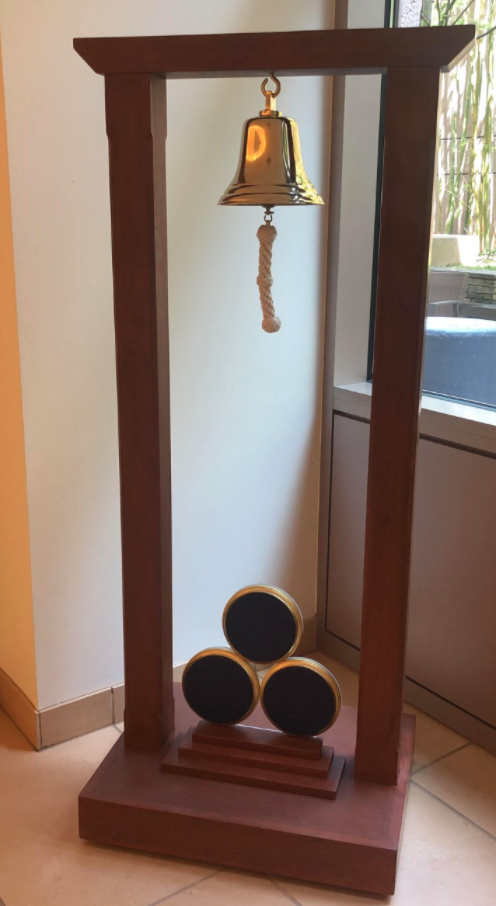





Your Treatment

Hopefully all your preparation has helped you feel a little more confident as you begin your treatments.
So let’s talk about what you can expect during each phase of your treatment:
- Your First Day
- Daily Treatments
- Your On-Treatment Visit (OTV)
- Your Last Day of Treatment
Your First Day
Our Visitor Policy

Stanford Health Care’s visitor policy is in place to keep our patients and staff as safe as possible during the COVID-19 pandemic.
Ask a member of your care team about our current policy to find out if a friend or loved one can be with you during your visit.
Arriving at Stanford Health Care
Remember when you arrived and checked in for your simulation visit? Your check-in will be the same for all your treatment visits.
- We will send you COVID-19 screening questions through MyHealth. Completing this survey helps make your check-in faster.
- If you cannot complete the MyHealth survey, a member of your care team will call you 1 to 2 days before your visit.
- You will need to answer COVID-19 screening questions when you enter the clinic. You will also be given a mask to wear.

When you arrive at Stanford Health Care, you will:
- Check-in at the same location where you did your simulation
- Verify your name and date of birth
- Walk down the hall to the patient only waiting area
- Meet with your radiation therapist who will take you to the treatment room
Your First Treatment
Now that you have completed your simulation, let’s go through what happens during your treatment days.
Click through each step to find out more about:
Positioning
Remember the mask or cradle that was customized to your body during simulation planning?
- Your radiation therapist will use these to get you in the correct position.
- The marks that the care team made on your skin will help the radiation therapist direct the radiation beam precisely at the treatment area.
Imaging
A position check will be done each time you have treatment.
- This is done before the “beam” is turned on.
- This check, using x-rays or other imaging, ensures that you are in the correct position.
Treatment
During the treatment, you will hold still while the machine moves around you and treats you from different angles. Nothing will touch you and you won’t feel a thing.
- How Long Will It Take? Treatments typically last about 20- 30 minutes. The exact time may vary each day. Your radiation doctor may order certain images to be done on some days.
- What You May Hear: Whooshing air sounds or whirling of the equipment.
- What You May See: You may see flashing lights from the machines.
What you hear or see from day to day may change, but your treatment will remain the same.
Some Helpful Tips:
- Try your best to relax– this can help you hold still during treatment, which is very important. Your care team can help you with relaxation techniques.
- If you like you can listen to music during your session to help you relax.
- If you have trouble relaxing during your treatment talk to a member of your care team so that they can find ways to help you.
Monitoring
Members of your care team will be watching you closely during the treatment and can talk to you anytime from outside of your room.
- They’ll guide you through the treatment and check in often to see how you’re feeling.
- If you feel nervous, anxious or claustrophobic, be sure to tell them so they can give you the support you need.
- If you need to stop the treatment for any reason, your treatment will restart.
Daily Treatments

Every time you come for a treatment, your radiation therapist will follow the same steps you experienced at your first treatment.
Although you’ll most likely have the same radiation therapists, staffing may sometimes vary due to vacations or schedule changes.
- You may be able to listen to music during your treatments. If this is something you’d like to do, just ask your care team if it’s possible.
- As your treatments progress, you will become more familiar with the routine.
- The treatment delivered each day is the same, even if the time it takes is different.
If you have any questions or concerns, especially about side effects or how you’re feeling emotionally, please let your care team know. They are there to make sure you feel comfortable during your treatments.
Your On-Treatment Visit (OTV)
What is an “on-treatment” visit (OTV)?
- Your radiation oncologist and other members of your care team will check in with you every week during one of your regularly scheduled treatment sessions. This is called an “on-treatment visit” (OTV).
- This visit will take place either before or after your treatment.
- At the OTV, you’ll meet with your radiation oncologist and a nurse to review your treatment, how it is going, and how you are feeling. This is a great time to discuss how to manage any side effects that you may be experiencing.
Preparing for your OTV
- Stanford Health Care’s visitor policy is in place to keep our patients and staff as safe as possible during the COVID-19 pandemic. Ask a member of your care team about our current policy to find out if a friend or loved one can be with you during your OTV visit.
- On your OTV days, you will need to plan to add about 30-45 minutes to your regularly scheduled treatment session.
What to Expect During an OTV
Meeting with Your Care Team
Your radiation therapist will take you to the nursing area, where a nurse or medical assistant will take your vital signs (temperature and blood pressure) and weight.
You will meet with members of your radiation oncology team to:
- review your radiation treatment
- manage any side effects you may have
- discuss any questions you may have
You may need your blood drawn once or twice a week based upon your treatment and if you are participating in a study.
Getting Support if You Experience Any Problems
- If you have any problems or symptoms on another treatment day (not an OTV day) – you can ask the therapist to call the nurse or doctor to see you.
- If it is after hours or on a weekend and non-urgent – you can use the MyHealth message system or call the non-urgent phone number you have been given. You will receive a response with 24 hours (business days).
- If it is after hours or on a weekend and an urgent matter – call the urgent/emergency number that you were given when you started treatment.
- If you have a life-threatening emergency, call 9-1-1
Your Last Day of Treatment
Soon, time will pass and your last of treatment will be here!
People react in different ways. You may want to celebrate this milestone, or let it pass quickly and quietly. Whatever you decide, take a moment to acknowledge the courage and strength it took for you and your loved ones to go through this treatment experience.

Your After-Visit Summary (AVS)
After your last radiation treatment, you’ll meet with a nurse to review your After-Visit Summary.
You will discuss:
- How to care for yourself after your radiation treatment
- When you should see your doctor next
- If you will need any imaging
- Skin care after treatment
- Information on any side effects that may linger after treatment
- If you need to see any of your other doctors
You will also receive a handout of the After-Visit Summary that also includes important contact information.
